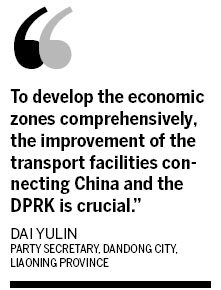Changes afoot as DPRK opens up
Updated: 2011-09-14 09:36
By Bao Chang (China Daily)
|
|||||||||||
|
A new bridge linking China and the DPRK under construction, seen from the Chinese side. The two countries are improving facilities connecting them to develop economic and trade exchanges. [Photo / China Daily] |
Regime tries to emulate China's policies, reports Bao Chang from Dandong city, Liaoning province.
Looking across the Yalu River at the Democratic People's Republic of Korea (DPRK), the country on the opposite bank seems mysterious and remote, with pale lights glimmering from a row of houses, vying for attention with the rising stars as night falls.
On the Chinese side of the river, the streets are awash with color from the neon lights flickering in Dandong's new district and presenting a very different nocturnal scene.
"The DPRK looks like China during the 1970s. I haven't seen many changes there over the past decades," said Li Jian, an elderly man who has lived in Dandong, a Chinese city that borders the DPRK, for more than 50 years.
However, an advertising board written in both Chinese and Korean, which has been standing on DPRK's Hwanggumpyong Island since June, says change is afoot and an opening up to the rest of the world is under way.
|
|
The agreement followed a visit to China by the DPRK's leader Kim Jong-il in May.
Emerging as if from hibernation, the DPRK is warming to Chinese-style economic reforms.
"The area will help boost the DPRK's foreign direct investment, turning the zones into a hot investment destination," said Dai Yulin, Party secretary of Dandong.
The first big investment opportunities are likely to come in the field of mineral mining as the infant market opens up. The DPRK's iron ore deposits are in the spotlight as steel makers expand capacity to meet the growing demand in the Asian and African markets, according to China Sunny & Forecasting Information Consultant Ltd (S&F), a Beijing-based market research company.
The amount of exploitable iron ore in the DPRK will reach 10 million tons annually by 2015, up from 6 million tons this year, an increase prompted by an expansion in investment by overseas companies, according to estimates from S&F.
The British company Global Steel Holdings Ltd has been negotiating with the DPRK government for a stake in the Musan iron ore mines in the country's North Hamgyong province, estimated to have reserves of more than 5 billion metric tons.
Pramod Mittal, a brother of the steel tycoon Lakshmi Mittal and the chairman of Global Steel, a closely held company of the Mittal family, visited Pyongyang last year, reportedly to talk to senior government officials and begin the groundwork necessary for gaining a share of the Musan reserves.
Mittal denied the claims. However, according to the Economic Times, he did add: "Our visit to North Korea is to further business interests. We are not looking for a stake in Musan." Meanwhile, companies from the Republic of Korea (ROK), including Pohang Iron and Steel Co Ltd (POSCO) and Korea Resources Corporation, are also stepping up efforts to get a slice of the action in the DPRK.
Currently, there are some 200 mineral deposits in the DPRK, including rare earths, with reserves of 6 billion tons, with a potential value of $6.6 trillion, according to S&F.
Iron ore exploration is still in its infancy in the DPRK. The total mined iron ore was about 50 million tons between 1998 and 2008, or 8.3 percent of the entire reserve.
"As the DPRK opens up, more and more investors from all over the world, including Chinese enterprises, will enter the market. Most of them will be intent on investing in resources projects," said a permanent delegate with the family name Zhou at the Pyongyang office of China Aerospace Beijing Changfeng Co Ltd.
Meanwhile, recent years have seen several Chinese companies, including Sinosteel Corp, China Minerals Corp and Shougang Tonggang Group, enter the iron ore market in the DPRK.
Having entered the DPRK in 2006, through cooperation with a local steel factory, the Shougang Tonggang Group now imports iron ore worth 14 million yuan ($2.2 million) from the country annually.
China imported 1.81 million tons of iron ore from the DPRK in 2009, a slight decline compared with a year earlier.
However, S&F predicts that by 2015, iron ore exports from the DPRK to China will reach at least 4.2 million tons, double the figure this year.
Currently, between 25 and 35 percent of the DPRK's total explored iron ore deposits are exported to China each year.
"Chinese enterprises have obvious advantages when investing in the DPRK's mineral industry because we are not only geographically close to the market but also have ample financial support and the advanced technology that the DPRK needs," said a researcher at the Chinese Academy of International Trade and Economic Cooperation who declined to be identified.
Related Stories
DPRK allows China domestic trade cargo to ship via its port 2011-07-04 16:52
Trade zone to boost DPRK economy 2011-06-25 09:00
DPRK plans special economic zone to boost ties with China 2011-06-08 13:39
- Sina says to ensure info authenticity
- Property prices will fall in next 12 months, HK developer Lo predicts
- Banking watchdog warns of P2P loan risk
- Italy bond purchase may be on the cards
- Ping An OK'ed to invest in PE, property
- 32 held in 'gutter oil' crackdown
- Credit tightening hits Sinopec debt
- Changes afoot as DPRK opens up















